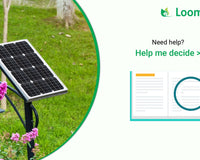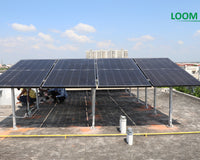Solar panels are super important for homes in Uttrakhand because there's lots of sunshine here. They help you save money on electricity bills which is extra useful when the power goes out. Introduced by the Uttarakhand government in November of the previous year, it is scheduled for launch during the financial year 2023-2028. According to the policy, the set goal for total solar target is 2,000 MW.
Components of a Solar System
Solar Panels: Solar panels are the heart of any solar system. These panels are made up of photovoltaic cells that convert sunlight into electricity. Solar panels come in many variants like DCR solar panels, monocrystalline solar panels, and bifacial solar panels. The most prominent choice is bifacial solar panel for residential purpose.
Solar Inverter: Solar panels generate direct current (DC) electricity, but most of our household appliances use alternating current (AC). So, we need a solar inverter to convert DC into AC. On grid solar inverters are a crucial part of the system, they come in different sizes 3KW, 5 KW, 8 KW and 10 KW.
Solar Batteries (optional): Some solar power systems include batteries to store excess electricity for use during cloudy days or at night. This is especially valuable in places with unreliable grid power, making sure you have electricity even when the sun isn't shining.
Mounting Structure: Solar panels need to be securely mounted on rooftops or the ground. The mounting structure not only keeps them in place but also ensures they are at the right angle to receive maximum sunlight.
Charge Controller (if using batteries): The charge controller regulates the flow of electricity to and from the batteries, preventing overcharging and prolonging battery life.
Wiring: Proper wiring are essential to connect all the components of the system safely and efficiently. These wires transport electricity from the solar panels to the inverter, batteries (if present), and then to your home or the grid.
How to apply for Net Metering?
Net metering is important for solar subsidies in Uttarakhand because it helps more people use clean energy. With net metering, solar panel owners can sell extra electricity back to the DISCOM and earn money. This encourages more people to choose solar power, which is good for the economy.
To apply for a net meter in Uttarakhand, follow these simple steps:
1. Register on Uttarakhand Power Corporation Ltd Portal.
2. Fill the application form for net meter.
3. Now, UPCL will assess the application and perform a technical feasibility evaluation.
4. If the technical feasibility is confirmed, you will be issued a No Objection Certificate (NOC). If you are eligible for a subsidy, UPCL will issue an In-Principle Sanction Letter.
5. Then submit the signed Power Purchase Agreement to UPCL and proceed with the installation of the solar rooftop system.
Type of Rooftop Solar System
On Grid Solar System: If you want to reduce your electricity bill up to 80% then on grid solar system is an optimal choice for you. An on-grid solar system, also known as a grid-tied solar system, that system is connected to the electricity grid, and this will help you to save money form the electricity bills. As well as you can sell excess generated electricity back to the DISCOM and earn money with that.
Off Grid Solar System: If you live in a remote area or experience frequent power cuts, you may want to consider an off-grid solar system. An off-grid solar system includes batteries to store excess power for use during times when the sun is not shining.
Hybrid Solar System: A hybrid solar system is a combination of an “on-grid” and “off-grid solar systems”. It is basically a grid connected system that comes with a battery backup. So, it has the advantage of both you can store excess power in the battery for use during an emergency time as well as you can sell the surplus generated power to the grid and earn money.
According, to the solar professional “Hybrid Solar System” is the optimal choice because from this you can reduce your electricity bill as well as get power backup during emergency time. This makes it a popular choice for residential installations.
Solar Panel Subsidy Scheme
Both central and state government offer subsidies schemes to people for installation the rooftops solar system.
Central government subsidy scheme:
Central government subsidy scheme is known as DBT (Direct Bank Transfer). In this scheme the subsidy amount will be directly transfer into the customers bank account with in the 30 days of commissioning of the solar system. You can get central government subsidy by applying through the National Portal for Solar Portal.
State government subsidy scheme:
While these rates are generally applicable across most of the country, the Ministry of New and Renewable Energy (MNRE) offers slightly higher Central Financial Assistance (CFA) to encourage solar adoption in northeastern states and regions with challenging hilly terrains.
Individual Households with a solar capacity of up to 3 kW: ₹17,662 per kW.
For rooftop solar capacity ranging from 3 kW to 10 kW: ₹17,662 per kW for the initial 3 kW and ₹8,831 per kW for the additional capacity. For plant capacities above 10kW, a fixed amount of ₹ 1,14,803 will be given
Solar Panel Subsidy Price
| Capacity | Central Subsidy | State Subsidy |
| 2 KW | 29,176 | |
| 3 KW | 43,764 | |
| 4 KW | 51,058 | |
| 5 KW | 58,352 | |
| 6 KW | 65,646 | |
| 7 KW | 72,940 | |
| 8 KW | 80,234 | |
| 9 KW | 87,528 | |
| 10 KW | 94,822 |
Both central and state offers the solar subsidy, for the general category states the central government pay 30% amount for the total as a subsidy. But for special states like Himachal Pradesh, Uttarakhand, Sikkim, J&K and Lakshadweep the central government pays the 70% subsidy amount. If your state doesn’t offer the subsidy on solar you can avail the central government subsidy by applying through the National Portal for Solar Portal.
If you want to interest in getting a subsidy you need to follow some guidelines. You must contact the electricity provider or DISCOM and apply online with the necessary documents. Their person will visit your site for a review and gives you an approval. Then the electricity provider visits for inspection. Customers can then avail the subsidy amount.
What is the entire process?
To apply solar subsidy, you should follow the following steps:
Step 1: Site Survey. Book Engineer Visit from here.
Step 2: System Capacity, Costing & Performance Analysis
Step 3: Buy Solar System & Installation
Step 4: Apply for Net Metering
Step 5: Get Solar Subsidy after 30 days of rooftop solar panel installation.











